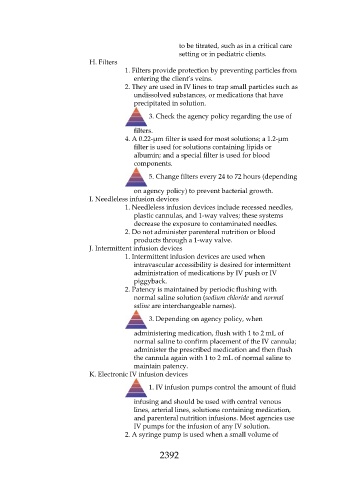Page 2392 - Saunders Comprehensive Review For NCLEX-RN
P. 2392
to be titrated, such as in a critical care
setting or in pediatric clients.
H. Filters
1. Filters provide protection by preventing particles from
entering the client’s veins.
2. They are used in IV lines to trap small particles such as
undissolved substances, or medications that have
precipitated in solution.
3. Check the agency policy regarding the use of
filters.
4. A 0.22-µm filter is used for most solutions; a 1.2-µm
filter is used for solutions containing lipids or
albumin; and a special filter is used for blood
components.
5. Change filters every 24 to 72 hours (depending
on agency policy) to prevent bacterial growth.
I. Needleless infusion devices
1. Needleless infusion devices include recessed needles,
plastic cannulas, and 1-way valves; these systems
decrease the exposure to contaminated needles.
2. Do not administer parenteral nutrition or blood
products through a 1-way valve.
J. Intermittent infusion devices
1. Intermittent infusion devices are used when
intravascular accessibility is desired for intermittent
administration of medications by IV push or IV
piggyback.
2. Patency is maintained by periodic flushing with
normal saline solution (sodium chloride and normal
saline are interchangeable names).
3. Depending on agency policy, when
administering medication, flush with 1 to 2 mL of
normal saline to confirm placement of the IV cannula;
administer the prescribed medication and then flush
the cannula again with 1 to 2 mL of normal saline to
maintain patency.
K. Electronic IV infusion devices
1. IV infusion pumps control the amount of fluid
infusing and should be used with central venous
lines, arterial lines, solutions containing medication,
and parenteral nutrition infusions. Most agencies use
IV pumps for the infusion of any IV solution.
2. A syringe pump is used when a small volume of
2392

